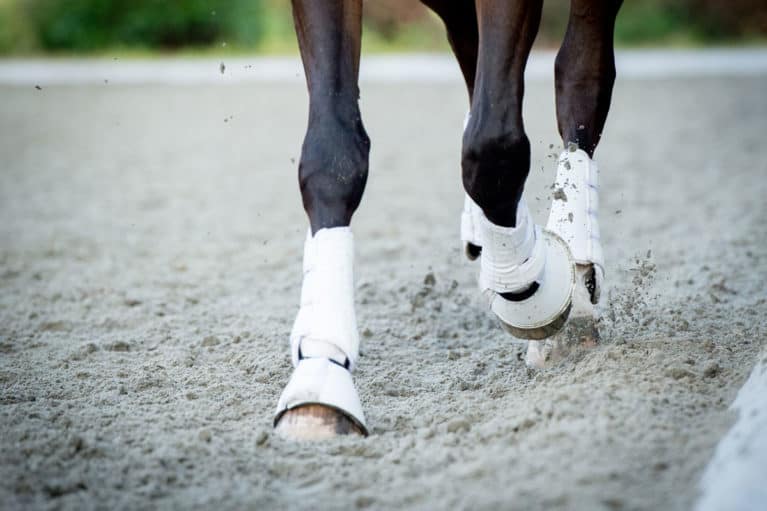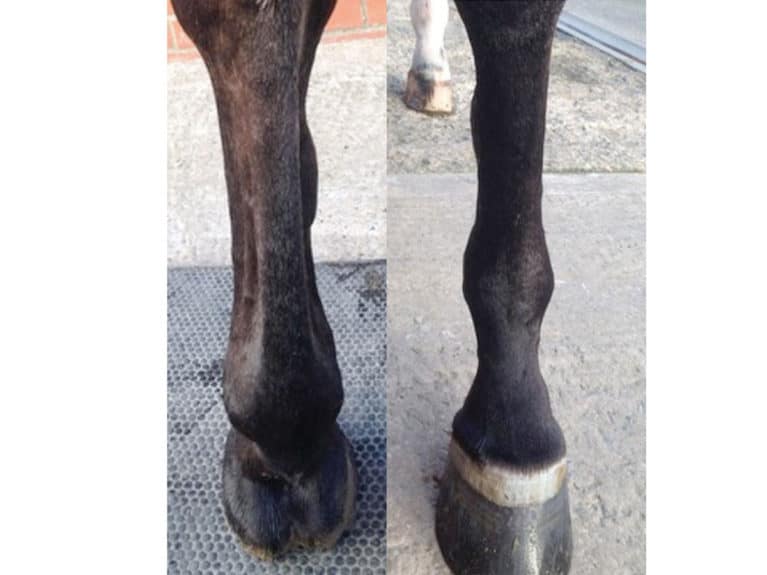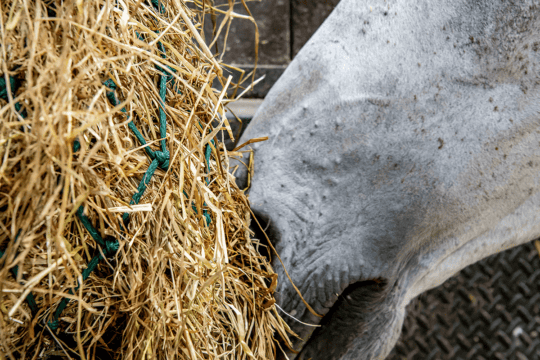On any yard, it’s likely at least one horse will have a splint. But just how serious are they and is there anything we can do to prevent them? Vet Rachel Read from Rossdales Veterinary Surgeons has the low-down.

Our Expert – Rachel Read DVM MRCVS is an orthopaedic assistant at Rossdales Diagnostic Centre, Newmarket. She grew up showjumping in Calgary, Canada, and carried this interest in the sport forward in her career, specialising in sport horse medicine and orthopaedics, and working with various teams as an FEI treating veterinarian.
If you know horses, then it’s likely you know splints. They are hard, bony swellings on the side of the lower leg, most commonly seen on the inside of the forelegs, and they occur when there has been some damage to the splint bone. They may only be a short-term nuisance or lead to a cosmetic blemish, but they can be more sinister, so it is important to understand when and how.
What are splint bones?
Splint bones are rudimentary metacarpal (forelimb) or metatarsal (hindlimb) bones that lie to the inside and outside of the cannon bone. The upper two-thirds of the splint is attached to the cannon bone with thick, tough, fibrous tissue, known as the interosseous ligament, and the bottom ends in a button-like rounding.
Cause and effect
Problems with the splint bones are common in young horses. Splints can arise due to a variety of factors, but can broadly be divided into two groups – as a result of either internal or external forces.
Internal
Splints can occur as a result of damage to the interosseous ligament, which can be caused by too much work on a hard surface, for example. This damage leads to a bone reaction (periostitis) on the surface of the splint and can lead to a visible lump, known as an exostosis.
In the early stages of this process there is often no visible swelling, which can make initial detection more difficult. Horses are usually more lame after work and deep palpation along the splint will often reveal an area of localised pain.
The resulting lump can vary greatly in size and initially may be painful on palpation, but usually quickly becomes non-painful once inactive.

External
Splints can also arise due to direct external trauma – for example, from a kick. In this case, a hard, bony lump forms as a result of a periosteal reaction (formation of new bone). The lump is usually smooth once it becomes inactive, but some may maintain an irregular margin.
Fractures of the splint bone can occur both at exercise and due to kick injuries. Those as a result of a kick can be more complicated, because they are often open injuries and can, therefore, be complicated by infection. They also often have a more fragmented nature.
Risk assessment
There are certain risk factors that have been shown to contribute to the development of splints. However, the good news is that there are steps you can take to limit the risk…
- Go slow with young horses Youngsters are sometimes rushed to certain targets and, although they may handle the pressure of more work, it could ultimately be more disruptive to their training due to time off that will be required to recover from a splint injury.
- Choose your riding surface carefully It has been suggested that the type of surface a horse is ridden on may cause injury. Although most people associate work on hard surfaces with splint development, it may be as important to avoid deep or uneven surfaces.
- Be aware of conformational abnormalities There may be certain conformational abnormalities and angular limb deformities, such as off-set knees or unbalanced feet post shoeing, that may predispose a horse to develop splints. If your horse has these predisposing issues, it could also mean that he’ll require a longer convalescent period.
- Take care with older horses Although they are more common in younger horses, if older horses develop splints, they tend to be more lame. Splint fracture is also more common in older horses because the interosseous ligament becomes more stiff or mineralised, and the splint bone more brittle. Obesity in older horses has also been linked to the formation of splints.
Checking for complications
Diagnosis of a splint is usually quite straightforward, but additional diagnostic techniques may be warranted if a fractured splint bone is suspected, which can be more complicated than a simple splint reaction. If this is the case, X-rays may be required, but abnormalities may not be visible for up to 21 days after the initial insult or onset of clinical signs. Therefore, your vet might recommend delaying taking X-rays for a few days or repeating them at a later date.
Some cases may require nuclear scintigraphy (bone scan) to confirm the diagnosis. This requires hospitalisation and injection of a radiopharmaceutical marker specific to bone. This highly-sensitive method is ideal for detecting bone insults, especially fracture.
Ultrasound can be used to assess the condition of the periosteum (the membrane that covers the surface of the bone) more specifically than X-ray, and the condition of the surrounding soft tissues. This is especially useful in cases that are suspected to be interacting with the suspensory ligament.
The healing period
There is no quick fix for splints, but early detection contributes to a better outcome. Management in the early stages can include box rest, cold hydrotherapy, counter pressure bandaging and anti-inflammatories (NSAIDS) such as phenylbutazone. A total rest period of a minimum of four to six weeks is usually recommended, but it can take up to 12 weeks for periosteal reactions to settle.
When bringing your horse back into work, it is important to take things slowly. Depending on his temperament, this may not be easy, but work should start with in-hand walking, then building up to increased ridden work over a few weeks. Care should be taken not to work your horse on excessively hard or uneven surfaces during this time.
In an ideal world, your horse will have built up to doing some work before he is turned out again. Initially, turn your horse out in a small pen, then gradually build up to a full-sized paddock over a
few weeks.
If the splint is unstable or your horse has been brought back into work too soon, it can result in excess new bone formation. Although it is a relatively rare occurrence, in the worst cases, this exuberant callus formation on the inside of the splint may impinge on the suspensory ligament.
Repairing a break
Where a splint has been fractured, surgical removal of fractured portions of the bone may be necessary. This is usually successful in cases that have fractures in the lower two-thirds of the splint.
However, if the upper third is affected, it may require internal fixation with screws or a plate to keep it stable – removing it could be detrimental to the knee or hock, leading to joint instability, lameness and arthritis.
There are two major exceptions to this…
- The inside splint bone of the forelimb should not have more than two-thirds of its lower length removed without internal fixation to stabilise it, as it bears a substantial amount of load at the knee.
- The outside splint bone of the hindlimb does not articulate or load bear and can be removed in its entirety with a good result.
In the case of open fracture with contamination of the wound, it may be necessary to keep your horse on an extended course of antibiotics or use antibiotic impregnated beads at the time of surgery (which will require removal).
If your horse has had to have his splint bone plated, he will probably need a second operation to remove the plate in three to four months, as the screw placement can affect the cannon bone integrity. The result of splint bone fractures repaired surgically is generally excellent and infection is the most common cause of complication.
Left with a lump
Usually, splints don’t cause any problems after the initial occurrence and may only result in a cosmetic blemish. The resulting lump rarely causes a problem, although your horse may knock into the splint more with his other leg and fitting boots may be more difficult. Bandages or sheepskin-lined boots will more easily conform to the limb and lump, and will protect against knocking it.
Removal of the bony lump is rarely performed and owners should keep in mind that this is unlikely to result in a blemish-free limb. It can lead to scar formation on the skin and recurrence of the lump is also possible, especially in the cases where there are conformational abnormalities in the limb.
It is usually recommended for cases where there is bony formation on the inside of the splint bone, which is not always visible, because it may impinge on the suspensory ligament and cause lameness. A few weeks’ box rest with a compression bandage is then necessary to allow for the best healing.
Mostly minor injuries
Splints are a common problem in riding horses, especially in youngsters, but they generally settle and usually only cause temporary riding set backs. However, it’s important to remember that early detection and a bit of patience are usually rewarded.











